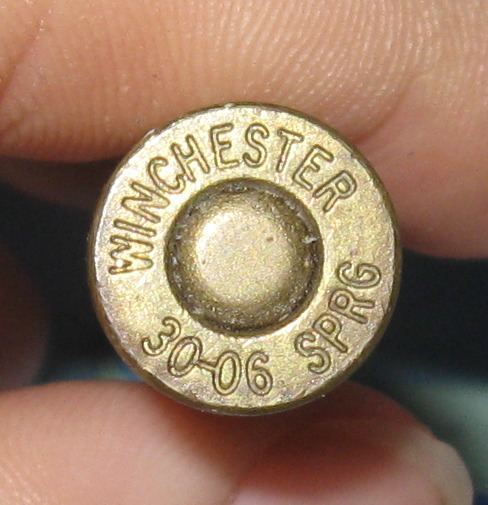Type Rifle Used by USA and others Designed 1906 | In service 1906 Designer United States Military | |
 | ||
Wars World War I, World War II, Korean War, Vietnam War | ||
Wildcat cartridges are firearms cartridges whose dimensions have been modified. Usually these modifications are with an eye toward improved performance, either measurable or not. This article deals with wildcat cartridges which result from a simple necking down or up of the original .30-06 Springfield where the overall case length is kept essentially the same. Many of these wildcats were more stages in the development of modern wildcat cartridges than they were a serious chambering in their own right.
Contents
Wildcats
.17-06 - necked down to accept a .17 Cal bullet - Appears to be mostly a rumor or joke as limited bullet availability, extreme case pressure and no ballistic benefit make it all but useless.
.20-06 - necked down to accept a .20 Cal bullet - Like the .17-06 the drawbacks of this wildcat make it an unreasonable cartridge.
.22-06 (alternately .223-06) - necked down to accept a .224 Caliber bullet similar to the popular .223 Remington. Due to the wide availability of .224 bullets this wildcat is rumored to have be incepted so that a barrel switch will let a familiar or comfortable rifle be used for varmint hunting. The similar .226 Express not only reduces neck diameter, but also reduces shoulder diameter to impose a long, slender body taper on the .30-06 case. Extensive experimentation during the mid-20th century indicated no practical benefit from the incremental volume the 63 mm .30-06 case over the 57 mm 7mm Mauser case for .22 caliber bullets.
.243-06 (alternately 6mm-06) - necked down to accept a .243 bullet - With the rising popularity of the .243 as a light deer rifle this wildcat is affordable to reload and offers lightened recoil .
.25-06 - necked down to accept a .25 bullet - Originally a wildcat this cartridge is now commercially available.
6.5-06 (alternately 6.5mm/06) - necked down to accept a 6.5 mm bullet - Very similar performance to the now commercialized .25-06.
.270-06 - necked down to accept a .270 bullet - This is essentially the .270 Winchester; although commercial cartridges use the slightly longer 65 mm .30-03 case from which the .30-06 was derived. Firing necked down .270-06 cases in a .270 Winchester may cause chamber erosion.
7mm-06 - necked down to accept a 7mm bullet - Originated during experimentation with the ballistic possibilities of popular 7mm bullets in plentiful .30-06 brass cases. The commercial .280 Remington (or 7mm Express Remington) is very similar, but uses the slightly longer 65 mm .30-03 case with the shoulder headspace extended slightly more than one millimeter (.05 inch) to prevent chambering in .270 Winchester rifles.
.303-06 - necked up to accept a .312 bullet - May have originated in markets where, at one time, the .312 bullet was easier to get.
8mm-06 - necked up to accept an 8mm bullet for improved ballistics using plentiful .30-06 brass cases in re-chambered military surplus 7.92×57mm Mauser rifles.
.338-06 - necked up to accept a .338 bullet - An effort to provide heavier bullets for bigger game with less recoil than other .338 offerings.
.35-06 - necked up to accept a .35 bullet - A successful effort to use heavier bullets for bigger game. Now commercialized as the .35 Whelen.
.375-06 - necked up to accept a .375 bullet - Also known as the .375 Whelen, it is another effort to use heavier bullets with plentiful actions and cases. The .375 Whelen Improved sharpens the .30-06 shoulder for more reliable headspace.
.400-06 - necked up to accept a .405 Winchester bullet - Better known as the .400 Whelen. Griffin & Howe chambered rifles for this cartridge, but headspace difficulties were reported with the small shoulder.
Parent cartridge
The .30-06 Springfield cartridge (pronounced “thirty-aught-six”, "thirty-oh-six") or 7.62×63mm in metric notation, was introduced to the United States Army in 1906 (hence “06”) and standardized, used until the 1960s and early 1970s. It replaced the .30-03, 6 mm Lee Navy and .30 US Army (also called .30-40 Krag). The .30-06 remained the US Army's primary rifle cartridge for nearly 50 years before it was finally replaced by the 7.62×51mm NATO (commercial .308 Winchester) and 5.56×45mm NATO (commercial .223 Remington), both of which remain in current U.S. and NATO service. It remains a very popular sporting round, with ammunition produced by all major manufacturers.
Parent cartridge dimensions
The .30-06 Springfield has a 68.2 grains (4.43 ml ) H2O cartridge case capacity. The exterior shape of the case was designed to promote reliable case feeding and extraction in bolt-action rifles and machine guns alike, under extreme conditions.
.30-06 Springfield maximum C.I.P. cartridge dimensions. All sizes in millimeters (mm).
